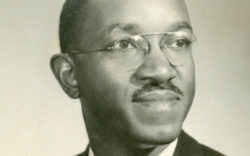Since the South’s interactions with the rest of the country are simply replete with examples of “incongruity between the actual result of a sequence of events and the normal or expected result,†I’ve always said that Southern historians would simply be forced to go out of business if we were no longer allowed to use any form of the word “irony.†A contemporary case in point lies in the controversial Arizona immigration bill now under scrutiny by the United States Supreme Court. According to the federal government’s brief in the case, in effectively adopting its own unilateral immigration policy focusing “solely on maximum enforcement,†Arizona has tried to “interpose its own judgments†on matters strictly delegated to the Office of the President of the United States. As the Feds point out, the Immigration and Nationality Act “vested the Executive Branch with the authority and the discretion to make sensitive judgments with respect to aliens, balancing the numerous considerations involved: national security, law enforcement, foreign policy, humanitarian considerations, and the rights of law-abiding citizens and aliens.†Allowing each state to establish its own immigration rules would therefore “wholly subvert Congress’s goal†of establishing “a single national approach.â€
The New York Times was quick to point to the irony here: “The word ‘interpose’ is a yellow flag in the history of state and federal relations. The southern states claimed a right of ‘interposition’ as a basis for secession before the Civil War, and they resurrected the idea in the 1950s. (Think John C. Calhoun and the “Nullification Crisis†in the first instance and Harry F. Byrd and “Massive Resistance†in the second,) Just as they claimed the right to interpose their power between the federal government and their populations over slavery and other issues in the 19th century, the Southern states claimed the right to ignore the Supreme Court’s desegregation order in Brown v. Board of Education.†(1954) Although the Supreme Court ruling in Cooper v. Aaron,(1958) “scorched†this ruse for maintaining racial discrimination in defiance of the Brown decision, the Times editorialist points to the “racial profiling†inherent in the Arizona law’s mandate for aggressive interrogation and scrutiny of all Hispanics, its ultimate goal being “separation by race.†This practice cannot be allowed to stand, the writer concludes because “just as racial equality was the law of the land during the desegregation era, it is the law of the land today.â€
Had our righteously indignant writer been a little more attentive to historical reality, he would have found even greater irony behind and within this case because, in fact, “racial equality was the law of the land†for more than half a century prior to the desegregation era as well. When the Supreme Court issued its landmark 1896 ruling in Plessy v. Ferguson, it upheld racially separate accommodations and facilities so long as they were “equal†in quality. Three years later, however, in keeping with its long-standing habit of seeking the narrowest possible reading of both statutes and case law appertaining thereto, the Court declined to intervene in a case where, despite its large black population, Richmond County, Georgia, provided no high school for black children at all.
Such judicial responses were all too typical over the next two generations before the courts finally began to show some disposition to give at least a little weight to the “equal†side of the “separate-but-equal†equation. By 1950, the justices would have no truck with the state of Texas’ attempt to establish, virtually overnight, a black “law school†consisting of a few rented offices and dog-eared law books and a faculty of equally rundown hacks looking to supplement the proceeds of their ambulance-chasing. No way,†said the guys on the bench, that such a setup could be construed as even remotely equal to that offered by the University of Texas at Austin, with its massive law library and large, distinguished faculty.
By the middle of the 20th century, Northern critics had a hard time understanding why, for the most part, even the most racially progressive white Southerners were not out rallying such supporters as they might have drummed up for an immediate, full-scale assault on Plessy. At least part of the answer lay in the fact that these folks were at that point still heavily engaged in trying to get Southern officials simply to comply with it, and one might add, risking both their reputations and sometimes their lives in doing so. At that point, ventured crusading Mississippi journalist Hodding Carter, the South was “the only place in the Western world where a man could become a liberal simply by urging obedience to the law.â€
As if to underscore Carter’s point, the initial litigation coming out of Clarendon County, South Carolina, that actually spawned Brown v. Board was focused not on overturning Plessy but on forcing the local school board to at least live up to it by providing transportation for black students just as it did for whites in this black-majority county. It was only as this effort progressed that the NAACP broadened the scope of its argument to declare that regardless of the relative quality of the facilities provided, segregated public education in any form was unconstitutional.
The entrenched pattern of severe racial discrimination, even—and sometimes especially—in counties where blacks made up the majority of the population, could be traced to a variety of disfranchisement measures that prevented more than a handful of blacks at most in such areas from getting anywhere near a ballot box. Largely bereft of political influence, their only hope lay in the courts, where, despite the prodigious efforts of the NAACP, anything resembling justice for blacks was exceedingly difficult to come by. In asking how black Southerners could be so thoroughly stripped of rights expressly granted them by both the 14th and 15th Amendments, we come quickly to the readiness of both Northern and Southern jurists to willfully suspend their instincts for disbelief. In the 1898 Williams v. Mississippi ruling that paved the way for the rest of the Southern states to proceed with vigor in actively disfranchising their black citizens, the Court upheld provisions in the state’s 1890 constitution mandating a literacy test, as well as payment of a poll tax, as prerequisites for voting. Clearly aimed at poor and illiterate blacks (although, in practice, the impossible stringency of the literacy test selectively applied to blacks meant that physicians and teachers often “failed†it as well), these two measures speedily trimmed the black electorate of a black-majority state down to 6 percent of the adult black population. Yet, because, on the face of it, the court could find no language in the Mississippi laws explicitly indicating racially discriminatory intent on the part of the state, it left these measures in place and thus left blacks in Mississippi and throughout most of the South with practically no voice whatsoever in how their local schools were operated and supported. (It was surely no coincidence that the courts and the Congress began to show interest in black rights only after the cumulative political effect of the exodus of millions of blacks from Southern states where they could not vote to Northern states where they could began to set in.)
At any rate, the longstanding judicial inclination to don blinders as well as robes and adhere to a narrow literalism that allowed the courts to sign off on blatant examples of state-imposed discrimination points to a final irony in our contemporary case. This one emanates not from the Arizona legislature but from none other than the chief justice of the United States Supreme Court, John Roberts, who must surely have struggled to suppress a grin when at the beginning of the government’s argument in United States v. Arizona, he told Solicitor General Donald Verilli, “I’d like to clear up at the outset what it’s not about. No part of your argument has to do with racial or ethnic profiling, does it? I saw none of that in your brief.†With that issue off the table for the time being at least, the Court’s conservatives were free to poke holes in the murkier and less compelling government contention that Arizona’s draconian immigration statute amounts to a usurpation of both congressional and presidential prerogative. Savoring the delicious irony of seeing a New York-born, Harvard-educated chief justice of the U.S. Supreme Court effectively assisting those whose ultimate aim is clearly to subvert federal authority, Calhoun and Byrd are surely somewhere cracking open a bottle of the good stuff and savoring their vindication as men not behind, but way ahead of their times.
Like what you just read? Support Flagpole by making a donation today. Every dollar you give helps fund our ongoing mission to provide Athens with quality, independent journalism.










